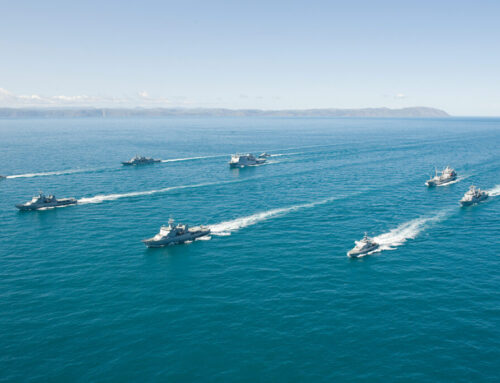Autor foto: Domena publiczna

Towards the NATO Summit in Warsaw
August 5, 2015
Author: PRZEMYSŁAW PACUŁA



Autor foto: Domena publiczna
Towards the NATO Summit in Warsaw
Author: PRZEMYSŁAW PACUŁA
Published: August 5, 2015
Pulaski Policy Paper, August 5, 2015
The NATO Summit in Newport, which took place in September 2014, was conducted in the shadow of the Russian military intervention against Ukraine and its increasing assertiveness towards the entire region of Central and Eastern Europe. Then NATO made decisions aimed at adapting itself to the changing security situation, both in the short perspective (e.g. rotational presence of allied forces in the region) and strategic perspective (including earmarking an immediate reaction force – VJTF from the NATO Response Force). These decisions were in line with Poland’s expectations, which called for both the strengthening of the strategic eastern flank of NATO, and significant improvements in the Alliance’s response mechanisms in crisis situations.
The unfavourable change in the security situation in Europe seems to be long-lasting. Russia’s aggressive moves aimed at destabilising the European order established after 1990, in particular including the breach of the principle of not using military force in international relations, the rhetoric of the authorities in Moscow, but also implemented plans for military reinforcement, are clear evidence of Russia’s adopting a long-term policy of confrontation with the West. Meanwhile from the south comes the rising tide of migration caused by, among others, a rebellion in the North Africa and the Middle East. The nature and scale of these challenges have proven that NATO must continue its strategic adaptation to new conditions.
The agenda of the Summit in Warsaw, which will be held on 8-9 July 2016, should therefore focus on the four core issues. Firstly, it is necessary to close the implementation of the provisions assumed at Newport. After nine months that have passed since the Summit, not only the decisions taken, but also the state of their implementation can be positively evaluated, including in particular the enforcement of a special plan (Readiness Action Plan, RAP), being, from Poland’s point of view, the most important element out of the solutions adopted in Newport. According to the decision of NATO defense ministers on 5 February 2015, it was determined that VJTF would include 5,000 soldiers, framework states were selected (this rotational role would belong to: France, Germany, Italy, Poland, Spain and the United Kingdom), and it was decided that full operability of this new structure would be announced in Warsaw. In the period from 9 to 19 June 2015 the first VJTF Noble Jump exercises with more than 2,000 NATO troops took place on Poland’s territory.
NATO Force Integration Units (NFIU) have been created in six countries of the eastern flank of NATO (Poland, Lithuania, Latvia, Estonia, Bulgaria and Romania) whose task is to facilitate the movement of NATO forces in Europe, coordination of exercises and planning, and should the need arise – preparing the adoption of larger forces support in the form of VJTF. Another realized element of the RAP is the so-called pre-positioning, i.e. the deployment of equipment and material in advance that could serve to accelerate the Alliance’s response in an emergency. Poland has also been seeking to strengthen the position of the Multinational Corps Northeast in Szczecin in the structures of the Allied Headquarters, so that it could ultimately become NATO’s operations command unit on the eastern flank of the Alliance. It is worth recalling that due to the decision of the summit in Newport on 4 September 2014 the level of readiness of the Corps was raised, and in April 2015 Great Britain became the 15th country participating in its structures.
Secondly, the Alliance should make a step forward in strengthening its border areas. Due to Russia’s actions the eastern flank is the most crucial point, in particular, Lithuania, Latvia and Estonia. NATO should strive towards building permanent and not just rotating military presence there. It should be emphasized that this postulate which used to be of more political nature in the past (based on the conviction of the uneven distribution of NATO infrastructure in Europe), has gained operational significance as a result of the new conditions. It stems from the fact that the permanent presence of NATO forces is a precondition for effective deterrence against hybrid aggression methods on NATO territory, including such familiar activities by Russia in Crimea as conducting operations below the threshold of an open, regular war.
Thirdly, it is necessary to further strengthen NATO defence capabilities as a whole, including its command structure and units as well as, defence planning and infrastructure. It is important to stop the downward trend in defence spending among NATO’s European members. It is worth noting that despite the adoption of declaration in this regard in Newport, in 2015 as many as 11 countries have cut defence spending calculated as a percentage of the GDP. In this context, it is worth stressing that due to the initiative of the former Polish President Bronislaw Komorowski, starting from 2016 Poland will earmark for this purpose at least 2 per cent of its GDP.
Map 1. Trend in defence spending of European NATO countries in 2015 compared to the previous year.
Also important from Poland’s point of view is the need to increase funding for joint allied defence infrastructure development in border states, which would allow, if necessary, the receiving of NATO support forces. In the process of creating VJTF it is necessary to develop a doctrine on their use, which should be based on the principle of pre-emptive development of these forces in the country threatened by a crisis, so that they can act as a deterrent.
Fourthly, due to the adoption of an assumption on the durability of changes of the European security environment it is necessary to adapt the doctrine of NATO operations to its new circumstances. The Summit in Warsaw could be a good opportunity to reflect on the new strategic concept of the Alliance, or at least the part concerning cooperation with Russia. Another important issue is NATO’s strategic preparedness for the challenges of the hybrid war. It is very important as under current conditions the Alliance might have a problem with working out a consensus in case such activities, below the threshold of an open, regular war, are taken up against one of its members.
Conclusions
1. Decisions made at the Summit in Newport have begun NATO’s strategic adaptation to the changes in security environment in Europe. The most important from the point of view of Poland is to ensure the continuous rotational presence of allied forces in the region of Central and Eastern Europe, the creation of immediate response force (VJTF) and the sprout of a permanent presence on the eastern flank of the Alliance in the form of NATO Force Integration Units.
2. Due to the permanent nature of changes in the European security environment, including, in particular, the confrontational course adopted by Russia, it is necessary to further adapt NATO to these threats and challenges. From Poland’s security standpoint decisions on the strategic strengthening of the Alliance’s eastern flank will be the most important.
Priorities for the NATO summit in Warsaw should include:
• Completing the implementation of the decisions of Newport (primarily RAP);
• Setting up a permanent NATO presence on border areas which are most vulnerable to the risks arising on the eastern and southern flank of the Alliance;
• Strengthening the defence capabilities of the Alliance as a whole, including its command structure, units, defence planning, and infrastructure and ensuring an adequate level of funding for defence spending, at both NATO level and by individual member states;
• Adopting a strategic reflection on the future of the Alliance, particularly with regard to relations with Russia and the risks associated with a hybrid war.
Author: Przemysław Pacuła, graduated in international economic and political relations at the Warsaw School of Economics. He has worked for the National Security Bureau since January 2007. He deals with issues related to NATO, foreign and security policy of the United States and issues of the region of Central and Eastern Europe. In 2008-2010 he was the head of the Euro-Atlantic Unit in the Department of International Security, and in the period from 2014 to 2015 was the head of the Unit of International Analysis in the Department of Strategic Analysis. He currently leads the Allied Security Unit in the Department of Strategic Analyses of the National Security Bureau.
Photo: NATO






